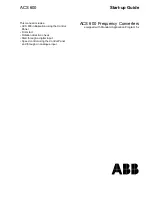
Page 9 of 12
6. Modbus connection
6.1. Modbus background
Modbus is a master-slave protocol, which means there are two types of Modbus device, Modbus
Masters
and Modbus
Slaves
.
Slave devices simply wait until they receive a command from a Master, act upon that command and send a reply to the
Master. Slaves do not have the ability to send commands to other devices on the bus. Master devices are responsible
for sending commands to slave devices and receiving data. Modbus only permits there to be one Master device on the
bus at any one time, but up to 247 slaves can be connected at a time.
Modbus is most commonly used over RS-485, which is a hardware standard allowing multiple devices to be connected
on the same bus.
Each Slave device must have a unique ID on the bus, which is referred to as a
Slave ID
. Each Modbus command the
Master sends will contain this Slave ID and only the Slave with that Slave ID will reply.
6.2. Modbus connections
For communication over RS-485 all 3 connections are needed. These are labelled A, B and GND. Please refer to the
connection diagrams below.
Caution:
The RS-485 cable must be a shielded data cable. Mains flex or other unshielded cable should not be used. The cable
shield should be connected to GND at one end only.
Caution:
RS-485 has polarised data connections. It is crucial that all ‘A’s are connected together, all ‘B’s are connected together
and all ‘GND’s are connected together.
Caution:
The RS-485 cable must be daisy-chained in a bus network. T-junctions (e.g. star network wiring) are not permitted.
Caution:
RS-485 biasing jumpers must be fitted on the M2M. Please refer to the diagram below.
Summary of Contents for Procon A1M
Page 2: ......
Page 4: ...Page 1 of 12 A RS 485 connector B CN105 CN92 connection lead 1 Fig 1 A B ...
Page 5: ...Page 2 of 12 2 Fig 2 ...
Page 15: ...Page 12 of 12 ...


































